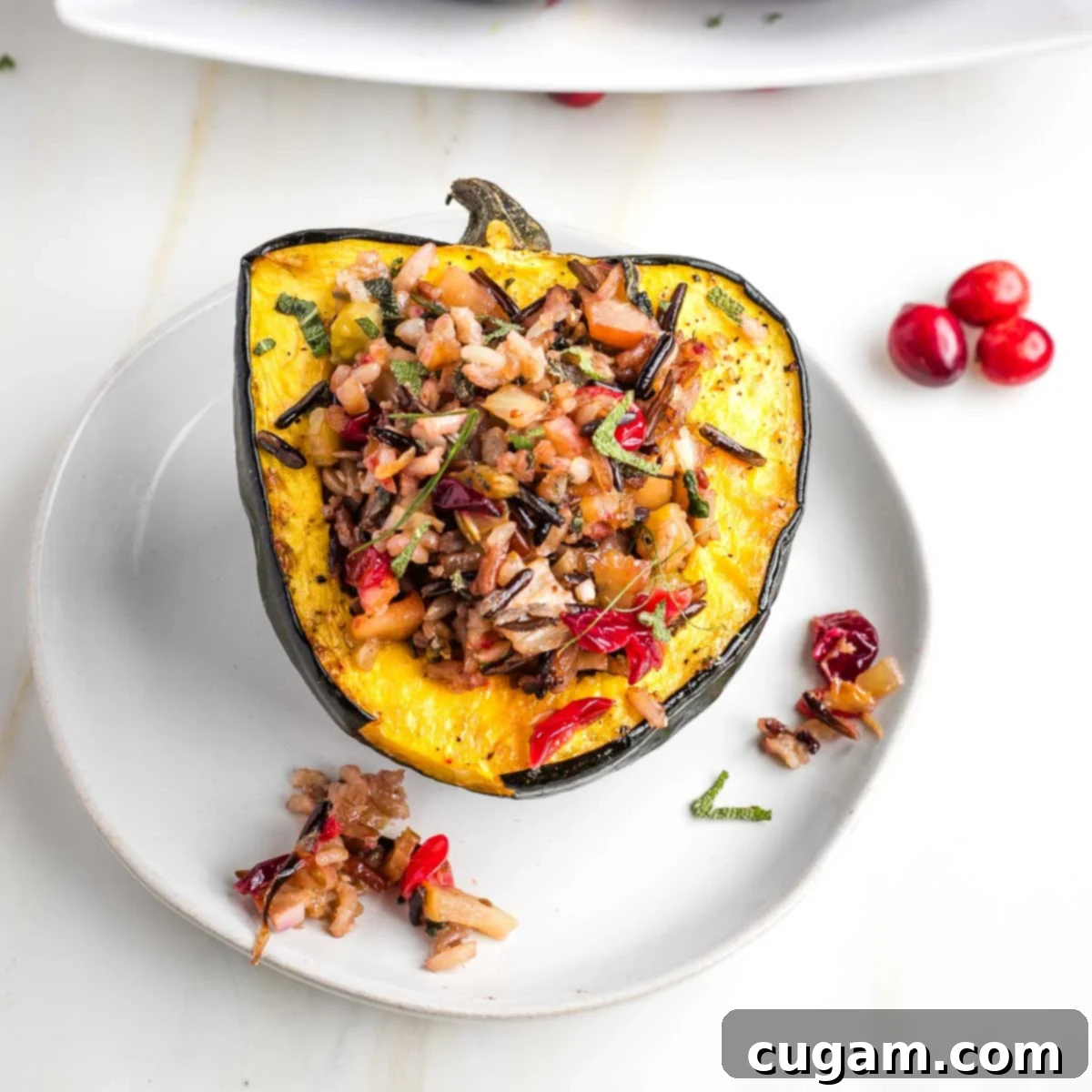The Best Vegan Wild Rice Stuffed Acorn Squash: A Hearty & Flavorful Fall Recipe
Prepare to fall in love with this incredibly delicious Vegan Stuffed Acorn Squash with Wild Rice Stuffing. It’s undeniably one of the most satisfying and easiest plant-based recipes you’ll make all season. Imagine perfectly roasted acorn squash halves, tender and naturally sweet, generously filled with a robust blend of vegetables and wild rice. This exquisite stuffing is bursting with all your favorite savory fall flavors, beautifully complemented by the tartness of fresh cranberries and the crisp sweetness of apples. It’s a dish that truly captures the essence of autumn on a plate, perfect for a cozy weeknight meal or an impressive holiday spread.
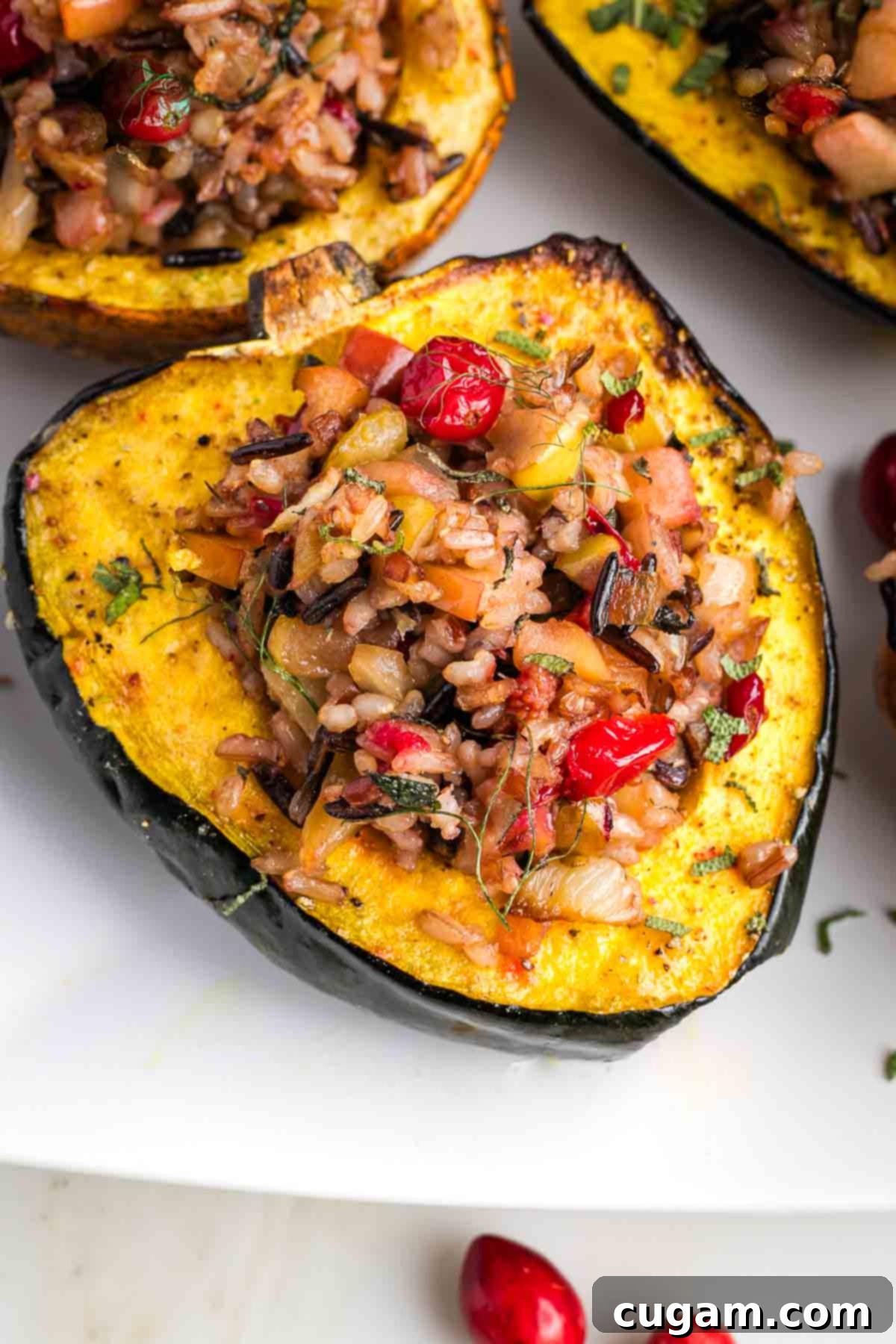
Acorn squash holds a special place in my kitchen. Its distinctive shape makes for a charming presentation, and its ease of preparation is a huge bonus. What’s more, the skin is entirely edible once cooked, adding extra fiber and texture without needing to be peeled. Beyond its culinary appeal, acorn squash is a nutritional powerhouse. It’s naturally sweet and packed with essential nutrients, including fiber, potassium, vitamin C, and magnesium. These elements contribute to digestive health, muscle function, immune support, and energy production, making it a fantastic addition to any diet.
This Vegan Stuffed Acorn Squash recipe is a hearty and fulfilling main dish that I prepare frequently. However, for those days when time is of the essence and I need something quick and comforting, my go-to is often mashed acorn squash – simple, sweet, and wonderfully easy. But when you want to impress or simply enjoy a more elaborate, yet still straightforward, meal, this stuffed version is unparalleled.
Why You’ll Adore This Acorn Squash with Wild Rice Stuffing
This recipe isn’t just a meal; it’s an experience. Here’s why it will quickly become a beloved staple in your recipe collection:
- The Perfect Vegan Thanksgiving Meal or an Easy Fall Dinner: Whether you’re planning a grand holiday feast or a simple weeknight meal, this dish fits perfectly. It’s elegant enough for a special occasion yet straightforward enough for any day.
- Delicious, Satisfying, and Nourishing: Every bite offers a symphony of textures and flavors, from the tender squash to the hearty wild rice and the fresh crunch of vegetables. It’s a meal that leaves you feeling truly satisfied and well-nourished.
- Harmonious Flavors: The sweet apples beautifully balance the tart cranberries, while the aromatic fennel and onion, paired with earthy sage, create a deeply savory and complex flavor profile that screams autumn.
- Versatile Gluten-Free Stuffing: The flavorful wild rice stuffing is naturally gluten-free and incredibly versatile. It can be served as a standout side dish on its own, perfect for those who enjoy the stuffing but prefer not to eat the squash.
- Hearty Plant-Based Main: This dish makes for an excellent plant-based main course, robust enough to satisfy even the biggest appetites during the cooler autumn and winter months. It’s a healthy, wholesome option that doesn’t compromise on flavor.
- Explore Other Stuffed Squash Options: If you’re looking to vary your stuffed squash game or prefer a quinoa filling, be sure to try my equally delicious Stuffed Butternut Squash Recipe.
Selecting the Perfect Acorn Squash: A Guide
Choosing the right acorn squash is key to ensuring your dish is as flavorful and tender as possible. Here’s what to look for when you’re at the market:
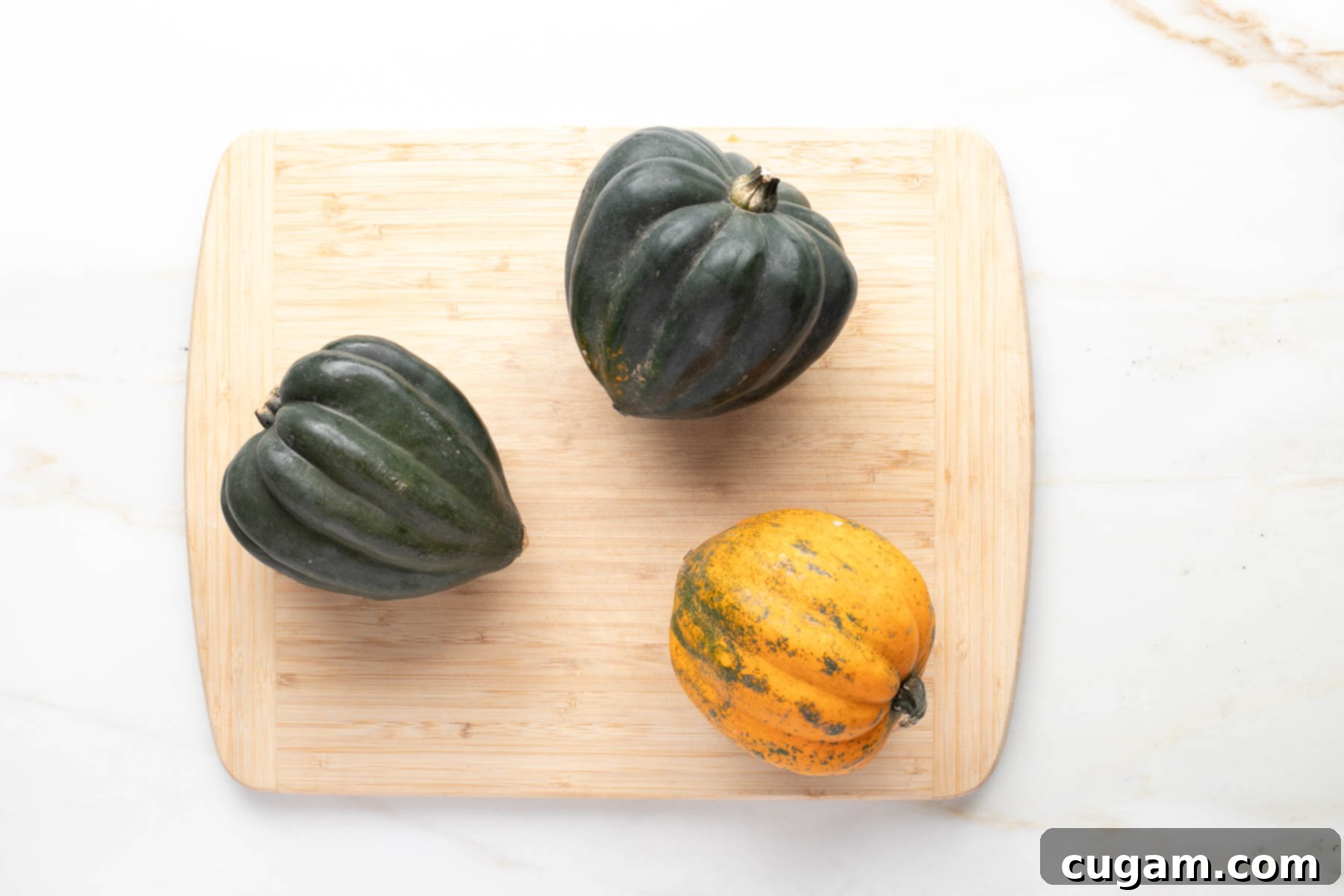
- Color: Opt for acorn squash with a deep, dark green skin. It’s common and perfectly fine to see some patches of orange or yellow, which indicate where the squash rested on the ground during growth. However, if the squash is mostly orange, it might be overripe, potentially leading to a stringy texture and less vibrant flavor.
- Skin Appearance: The skin should be firm, smooth, and have a dull finish. Avoid any squash with soft spots, bruises, or significant blemishes, as these can indicate spoilage. A shiny skin, surprisingly, often means the squash was picked prematurely and might not be as sweet or tender.
- Weight: A good acorn squash should feel heavy for its size. This weight indicates that it’s full of moisture, ensuring a moist and delicious flesh when cooked. Lightweight squash, on the other hand, might have lost moisture over time and could result in a dry texture.
- Storage: Once you’ve chosen your squash, store it in a cool, dry place away from direct sunlight. It can last for several weeks, or even up to a couple of months, when stored properly until you’re ready to use it.
Ingredients & Clever Substitutions for Your Stuffing
This recipe uses a blend of fresh, wholesome ingredients that come together to create a truly memorable meal. Don’t worry if you’re missing an item; many can be easily substituted!
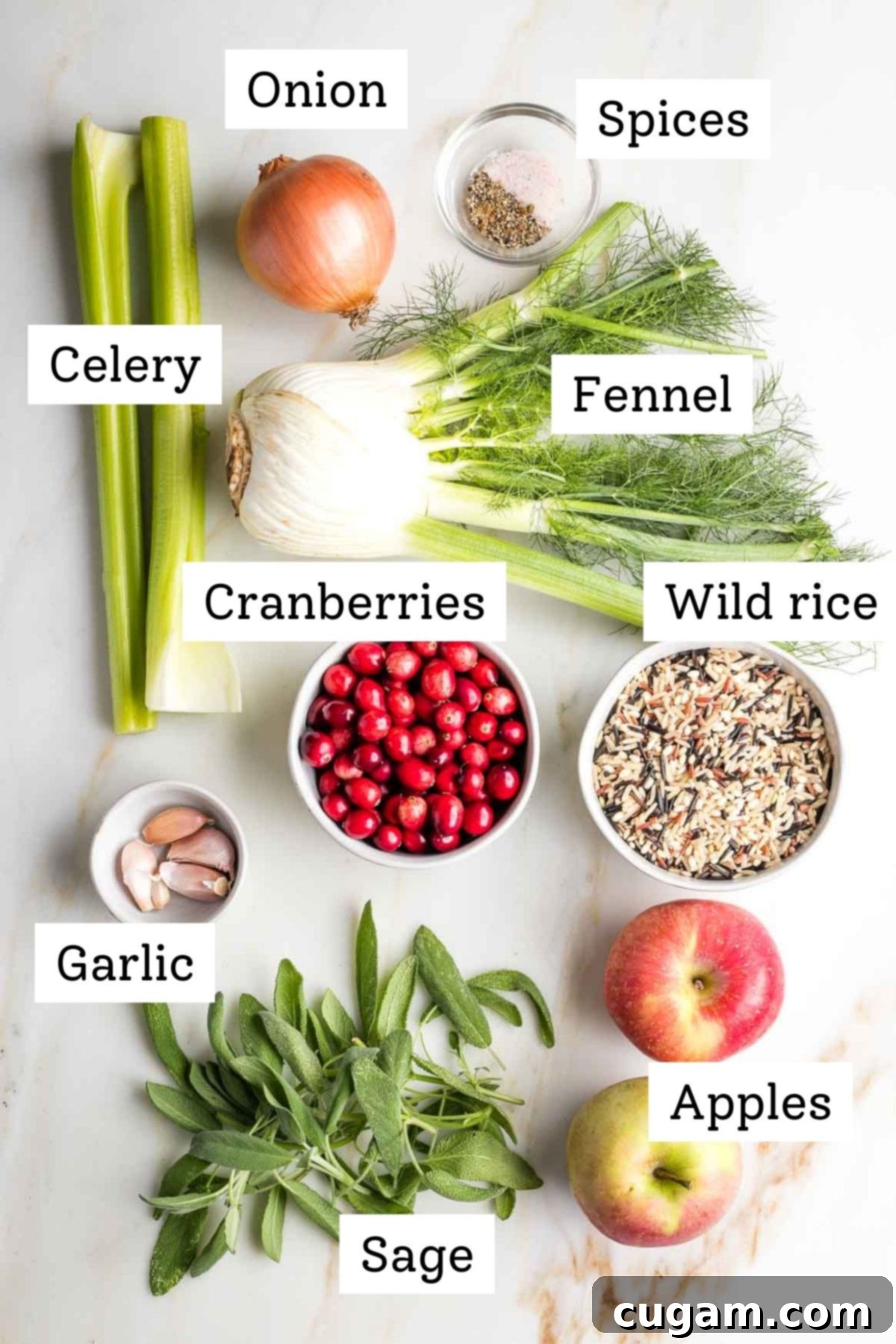
- Acorn Squash: While acorn squash is the star, other winter squash varieties can be fantastic alternatives. Kabocha squash, butternut squash, and buttercup squash are all great options that will yield similar sweet and tender results. Adjust cooking times slightly based on the size and density of your chosen squash.
- Wild Rice: This grain adds a wonderfully chewy texture and earthy flavor. If wild rice isn’t readily available, you can use a combination of black rice and white rice, or other whole grains like quinoa, farro, brown rice, or barley. Each will bring its own unique texture and nutritional benefits.
- Yellow Onion: The foundation of many savory dishes, yellow onion provides a sweet and aromatic base. You can easily substitute with leeks for a milder flavor, red onion for a bolder color and sharper taste, white onion, green onion, or even a sweet Vidalia onion.
- Celery: Adds a crisp texture and classic aromatic flavor to the stuffing. There isn’t a direct substitute that perfectly mimics its crunch and taste, but you can increase other veggies like carrots if you omit celery.
- Fennel: Don’t let the subtle licorice flavor of raw fennel deter you! When fennel is sautéed, it transforms into a sweet, caramelized, and incredibly tender vegetable, losing its anise-like notes. It adds a unique depth of flavor that is truly special in this stuffing.
- Fresh Apples: Any type of apple will work beautifully in this stuffing, adding a touch of sweetness and a pleasant textural contrast. Pears are also an excellent substitute, offering a slightly different, equally delightful sweetness.
- Cranberries: Fresh cranberries provide a burst of deliciously tart and tangy flavor that cuts through the richness of the other ingredients. If fresh cranberries are out of season or unavailable, you can substitute with dried cranberries. Just be sure to look for unsweetened varieties if possible and stir them in at the very end of cooking, as they don’t need to be cooked down like fresh ones.
- Garlic: The recipe calls for 4 cloves, but as a garlic lover myself, I encourage you to add more if you like! Minced garlic adds a fragrant, pungent kick that enhances all the other flavors.
- Fresh Sage: This herb is synonymous with fall flavors. For substitutions, fresh rosemary, thyme, oregano, or parsley would also work well, each offering a slightly different aromatic profile. If fresh herbs aren’t available, use approximately one-third of the quantity of dried herbs, as their flavor is more concentrated.
- Optional Sautéing Liquid: You have flexibility in how you sauté your veggies. Extra virgin olive oil provides richness, while vegetable broth or water can be used for an oil-free option. A splash of white wine can also add a sophisticated layer of flavor to the stuffing. Feel free to use a combination that suits your taste and dietary preferences.
Step-by-Step Guide: Crafting Your Stuffed Acorn Squash
Follow these detailed steps to create your perfect vegan stuffed acorn squash:
Step 1: Prepare and Roast the Squash
Preheat your oven to 400 degrees Fahrenheit (200°C). Prepare a rimmed baking sheet with unbleached parchment paper or use a 9×13 inch baking pan for roasting.
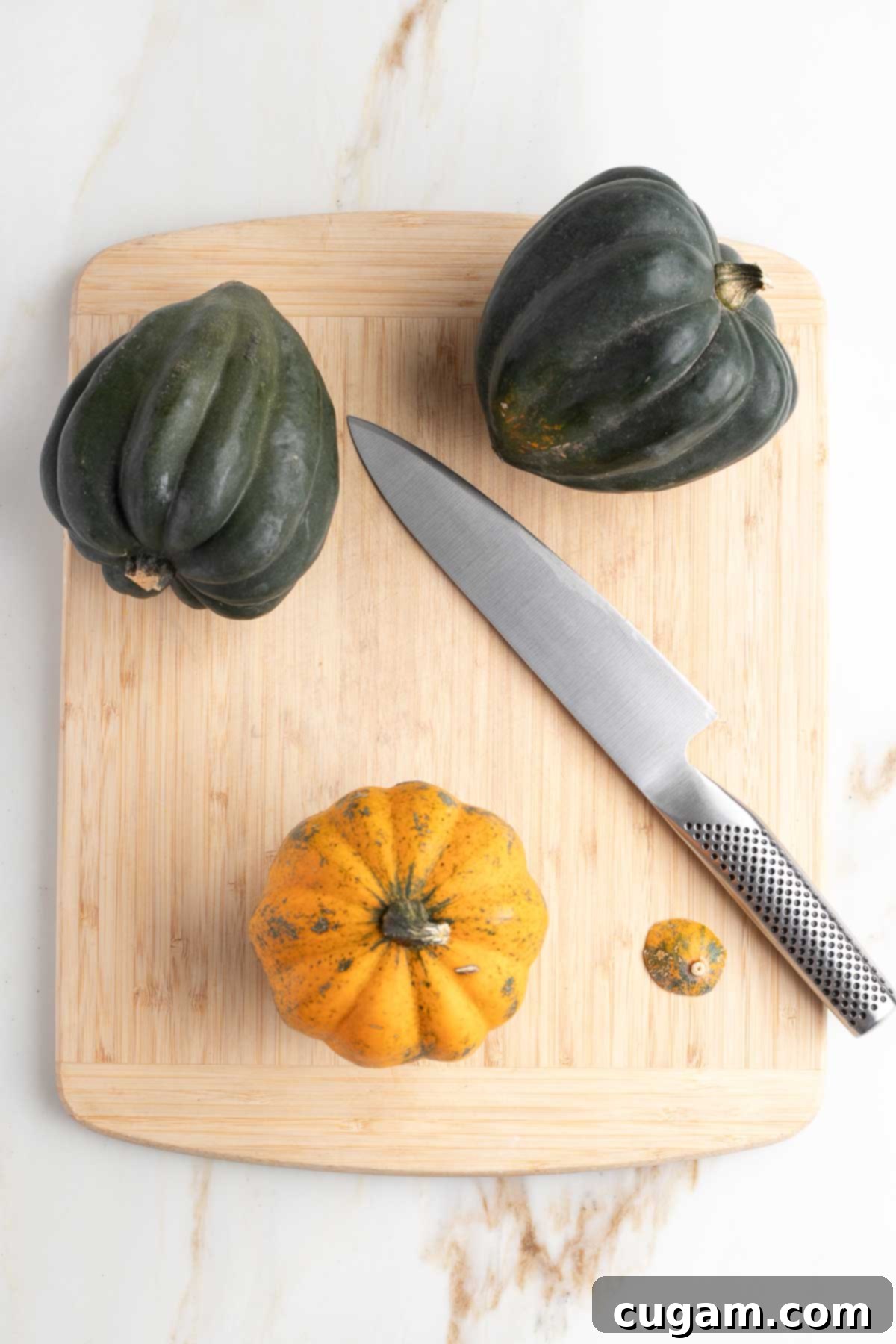
Carefully use a sharp chef’s knife to slice a small sliver off the bottom of each squash. This creates a stable base, allowing the squash to stand upright on your cutting board for safer handling.
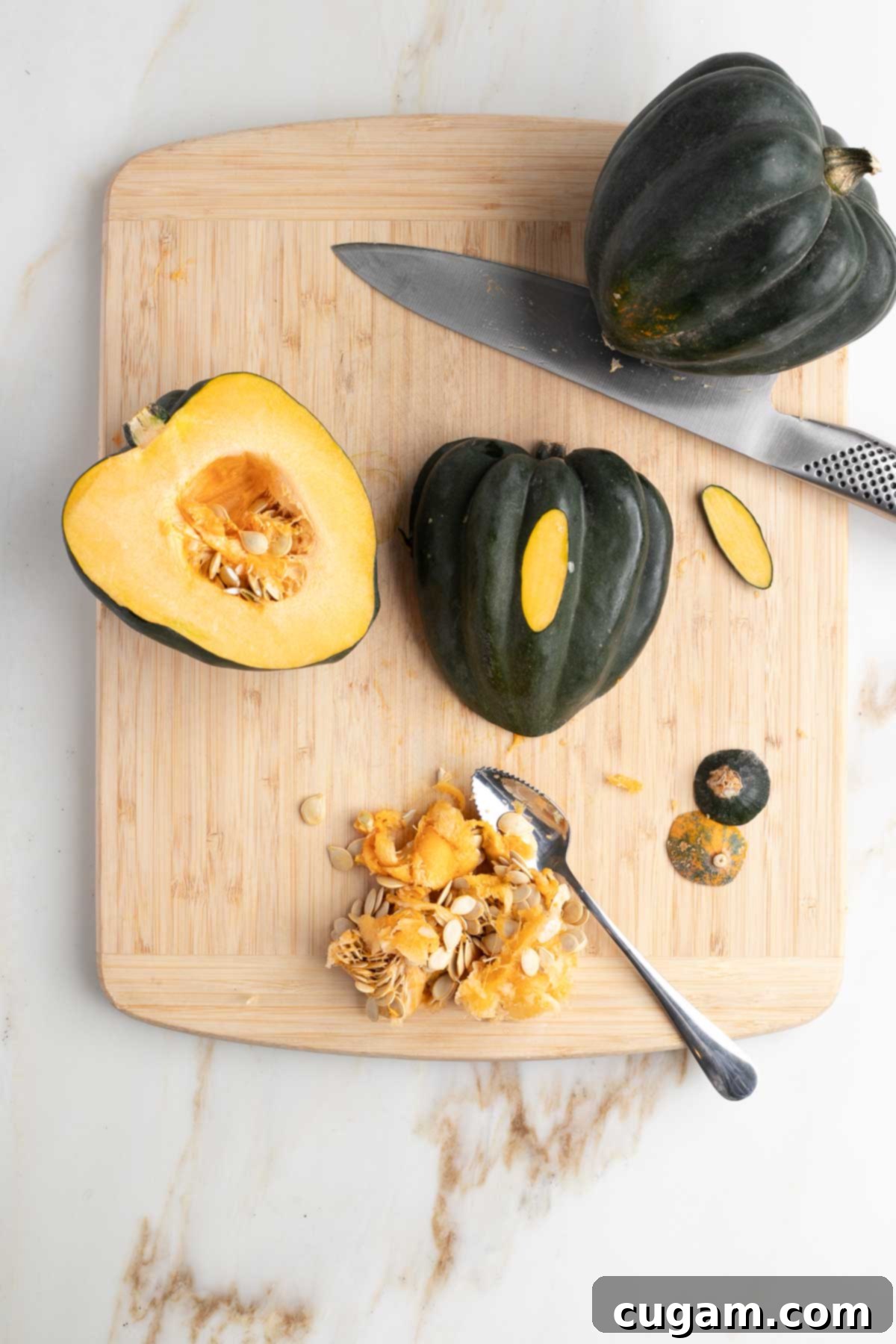
Cut each squash in half through the top, from stem to base. Use a sturdy spoon or, for easier seed removal, a grapefruit spoon, to scoop out all the seeds and stringy bits from each half. Discard these or set them aside to roast later for a crunchy snack!
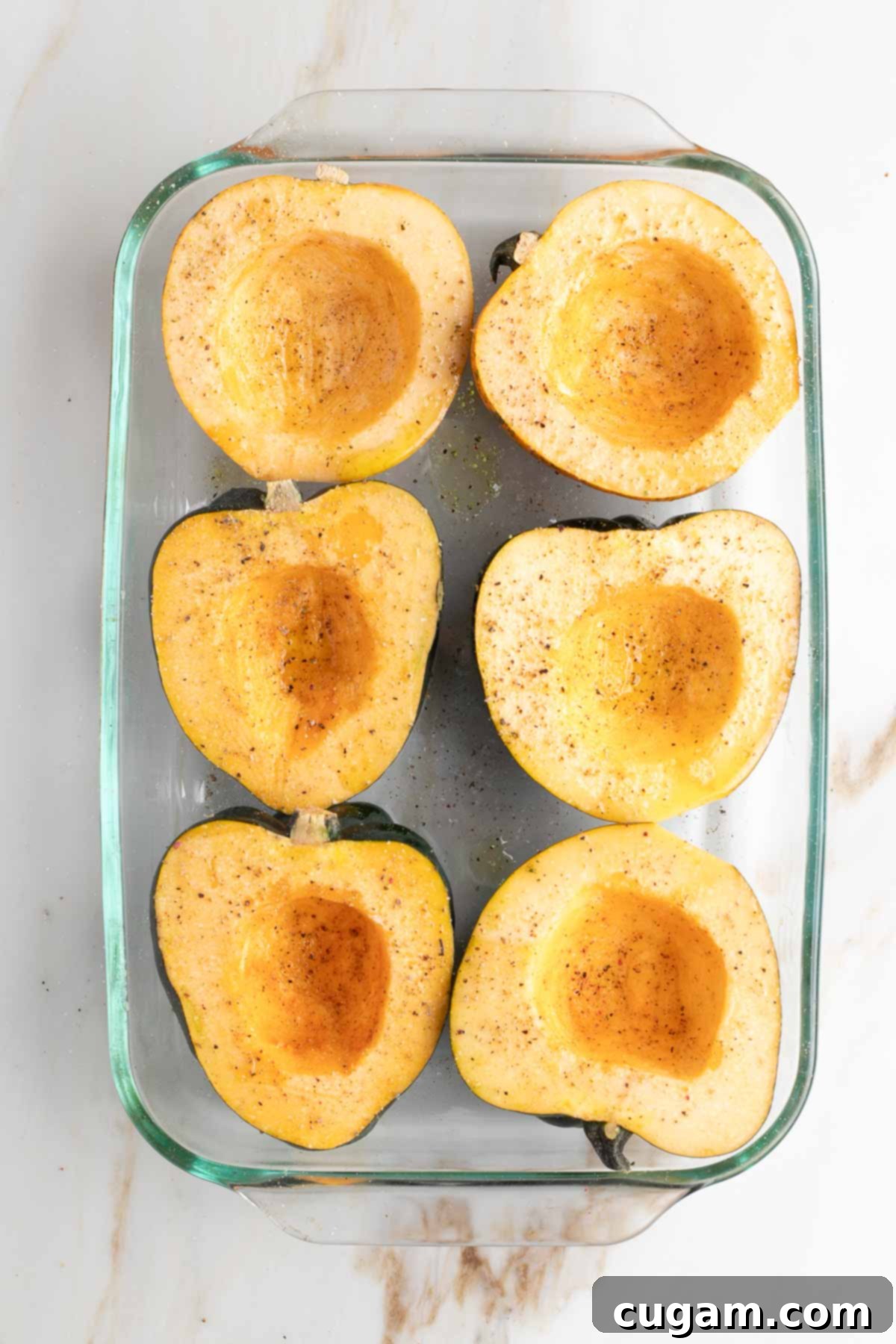
Place the squash halves, cut side up, in your prepared baking dish. Lightly rub a little olive oil over the exposed flesh, then generously sprinkle with sea salt and freshly ground black pepper. This seasoning will enhance the squash’s natural sweetness.
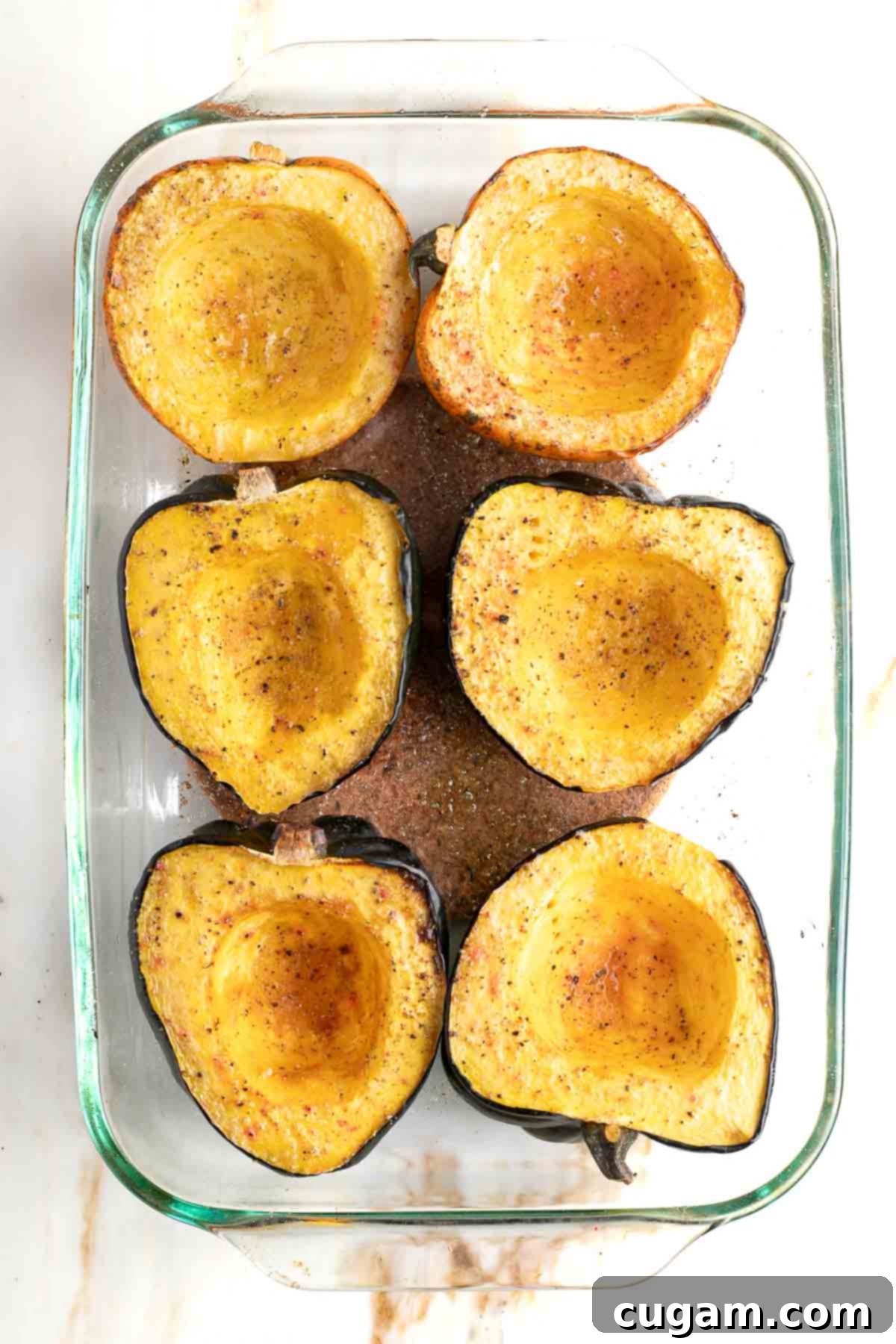
Bake in the preheated 400-degree F (200°C) oven for approximately 40-45 minutes. The exact cooking time will vary slightly depending on the size of your squash, so look for a fork-tender consistency when pierced.
Step 2: Cook the Wild Rice
While the acorn squash is roasting, you can prepare the wild rice for the stuffing.
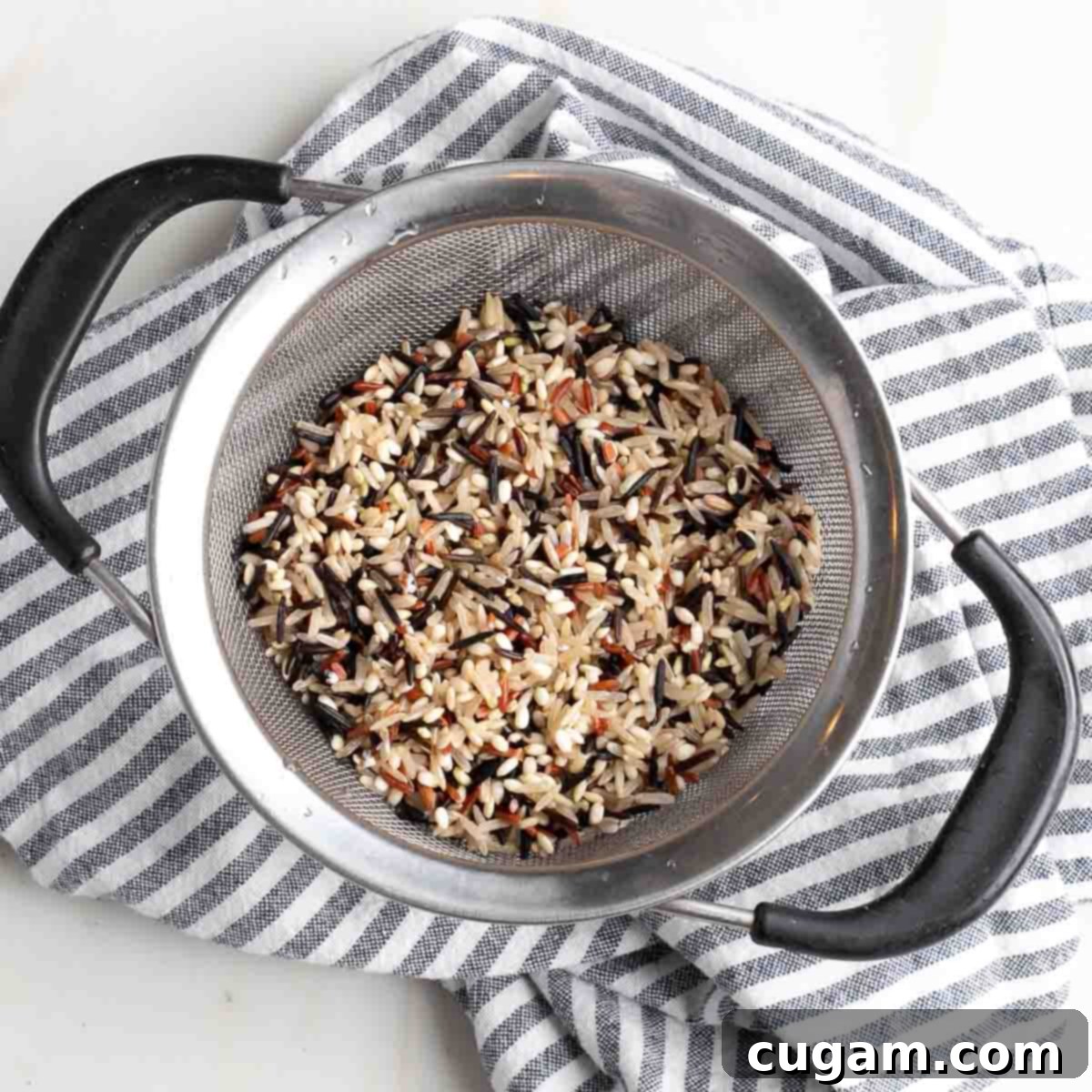
Place the dry wild rice in a fine-mesh sieve and rinse it thoroughly under cool running water until the water runs clear. This helps to remove any excess starch and ensure the rice cooks evenly.
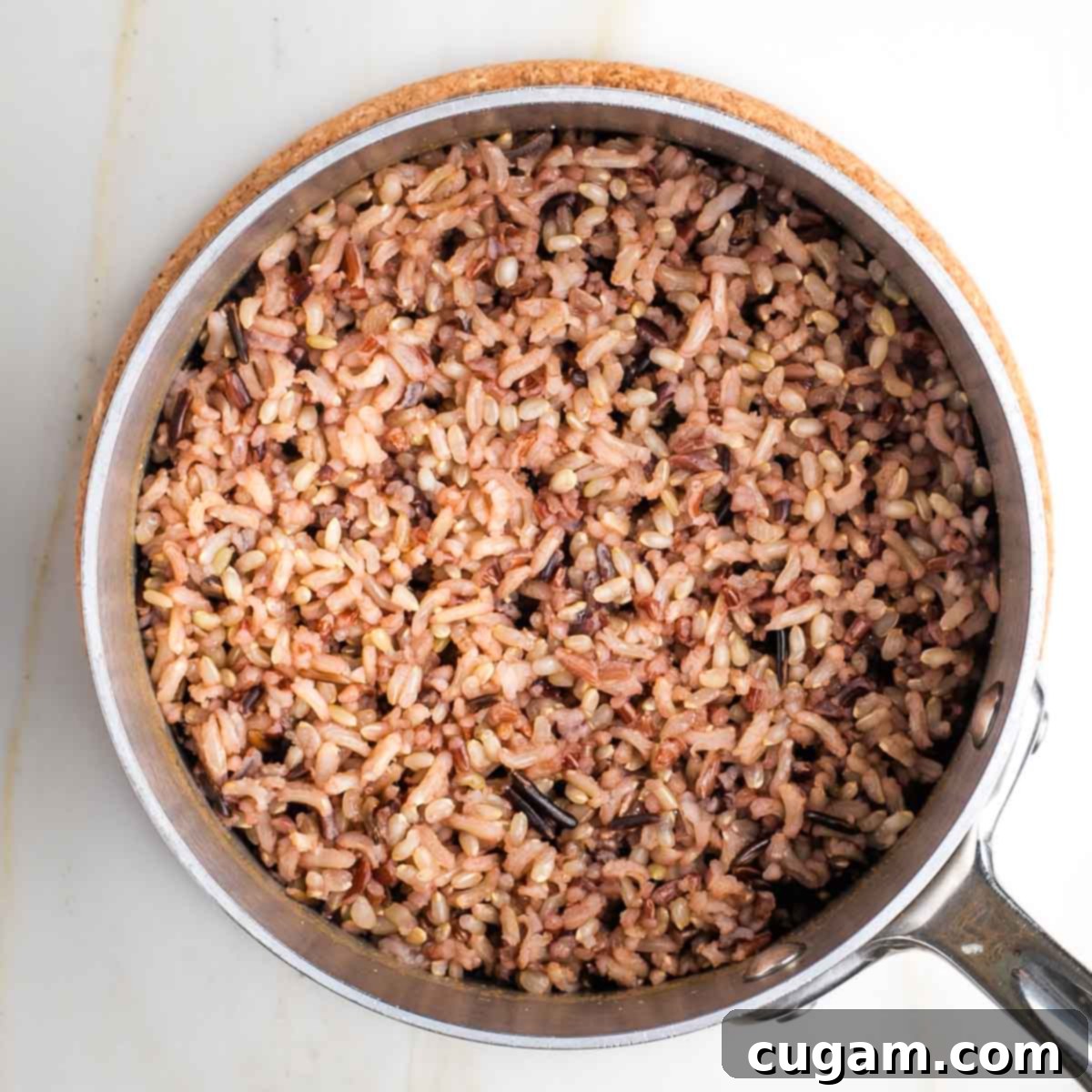
In a small saucepan, bring 2 cups of vegetable stock (or water) to a boil over medium-high heat. Stir in the rinsed wild rice, then reduce the heat to medium-low, cover the saucepan tightly, and let it simmer for about 25 minutes. Alternatively, follow the specific package instructions for your wild rice, as cooking times can vary. Once cooked, turn off the heat and leave covered for 10 more minutes to steam, ensuring fluffy results.
Step 3: Prepare the Stuffing Vegetables and Fruits
Efficient prep work makes the rest of the cooking process a breeze!
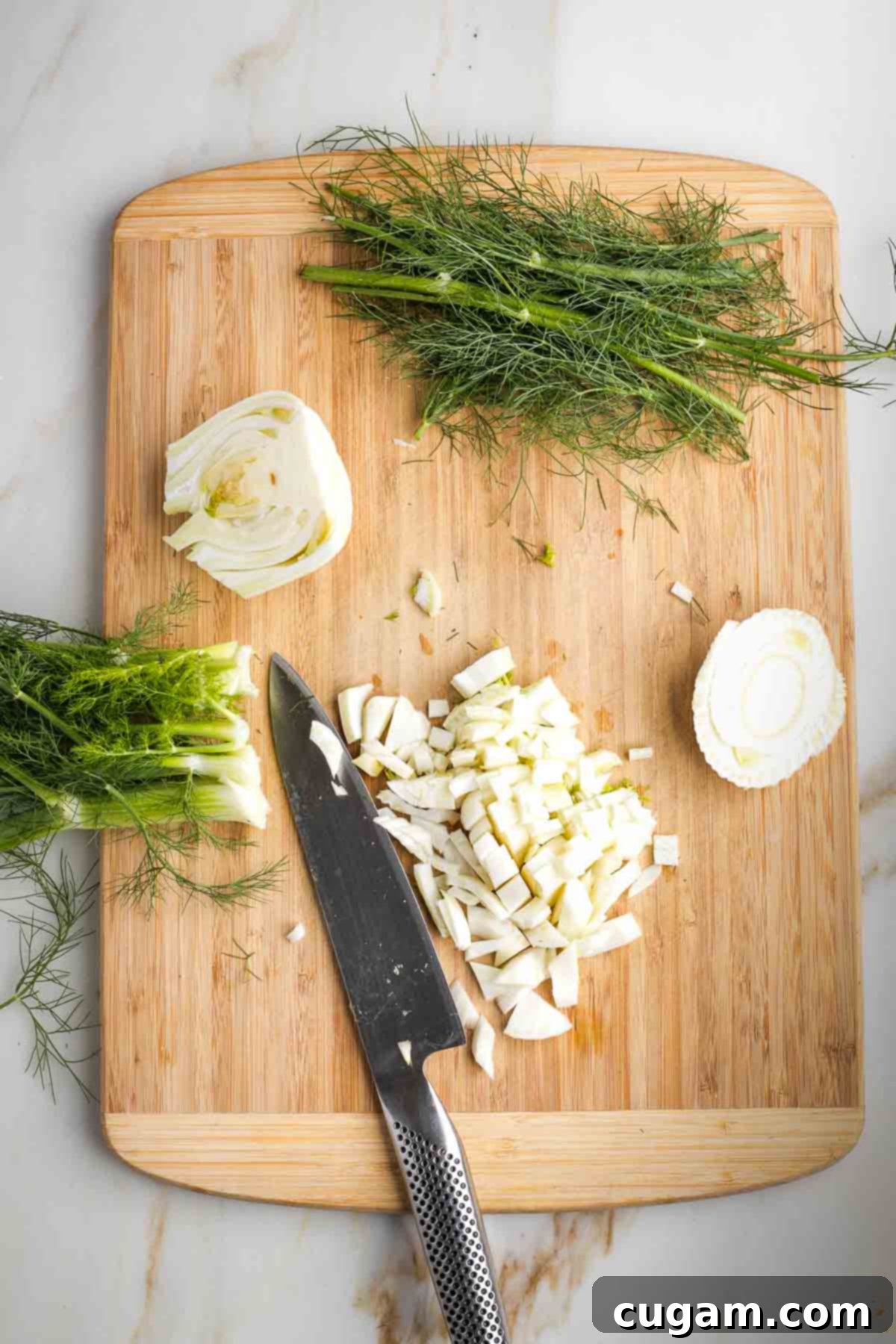
To dice the fennel: first, slice off the woody bottom and any leafy fronds at the top (save the fronds for garnish if desired!). Cut the bulb in half through the center, then place each half cut-side down. Make thin slices, and then cut across the other way to create a fine dice. This will help it soften beautifully.
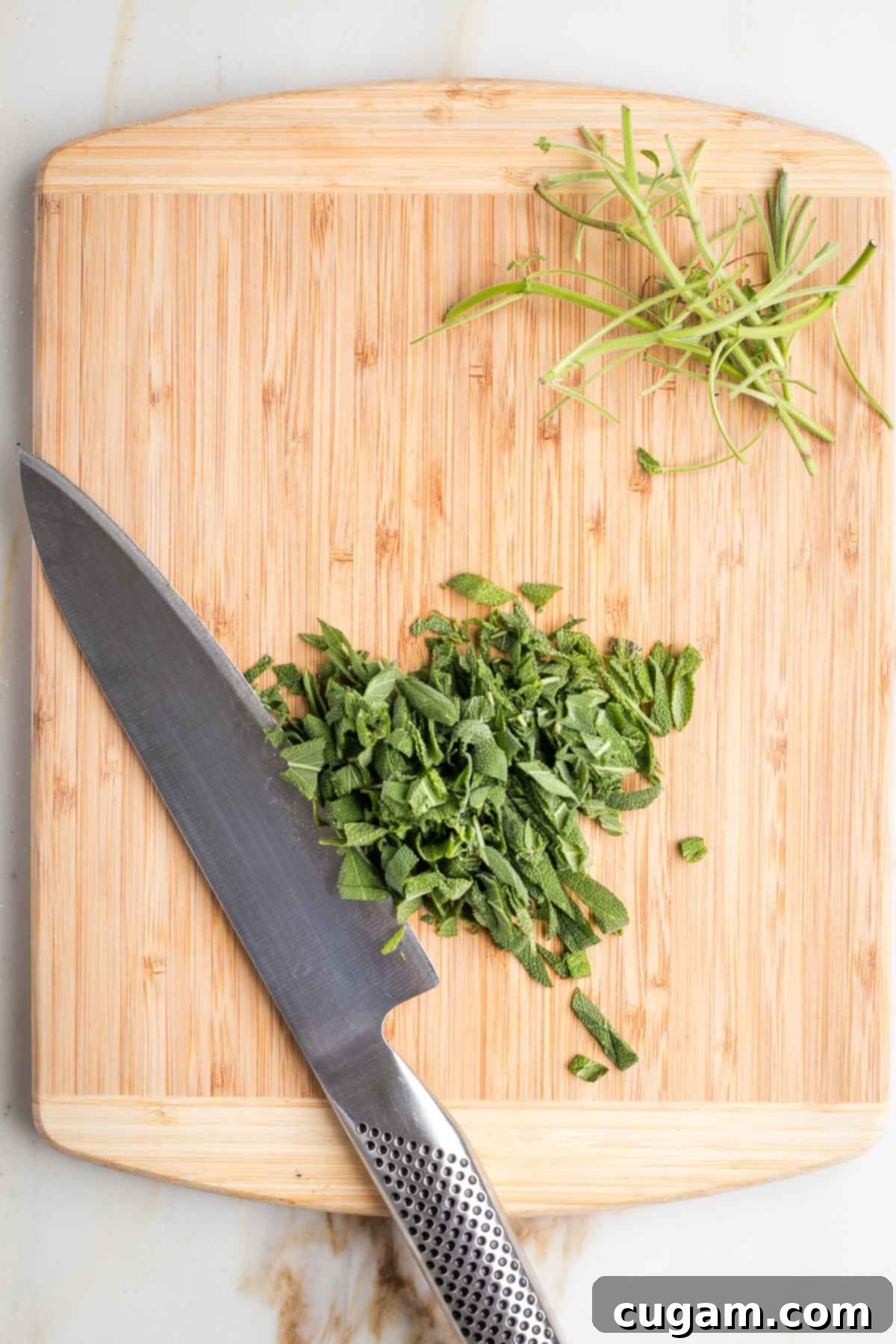
Stack the fresh sage leaves and roughly chop them. Next, dice your onion, celery, and apples into uniform pieces. Mince the garlic cloves finely. Finally, rinse the fresh cranberries under cold water and carefully pick out any stems or damaged berries, ensuring only the best go into your stuffing.
Step 4: Cook the Stuffing
Now it’s time to bring all those delicious flavors together for the stuffing!
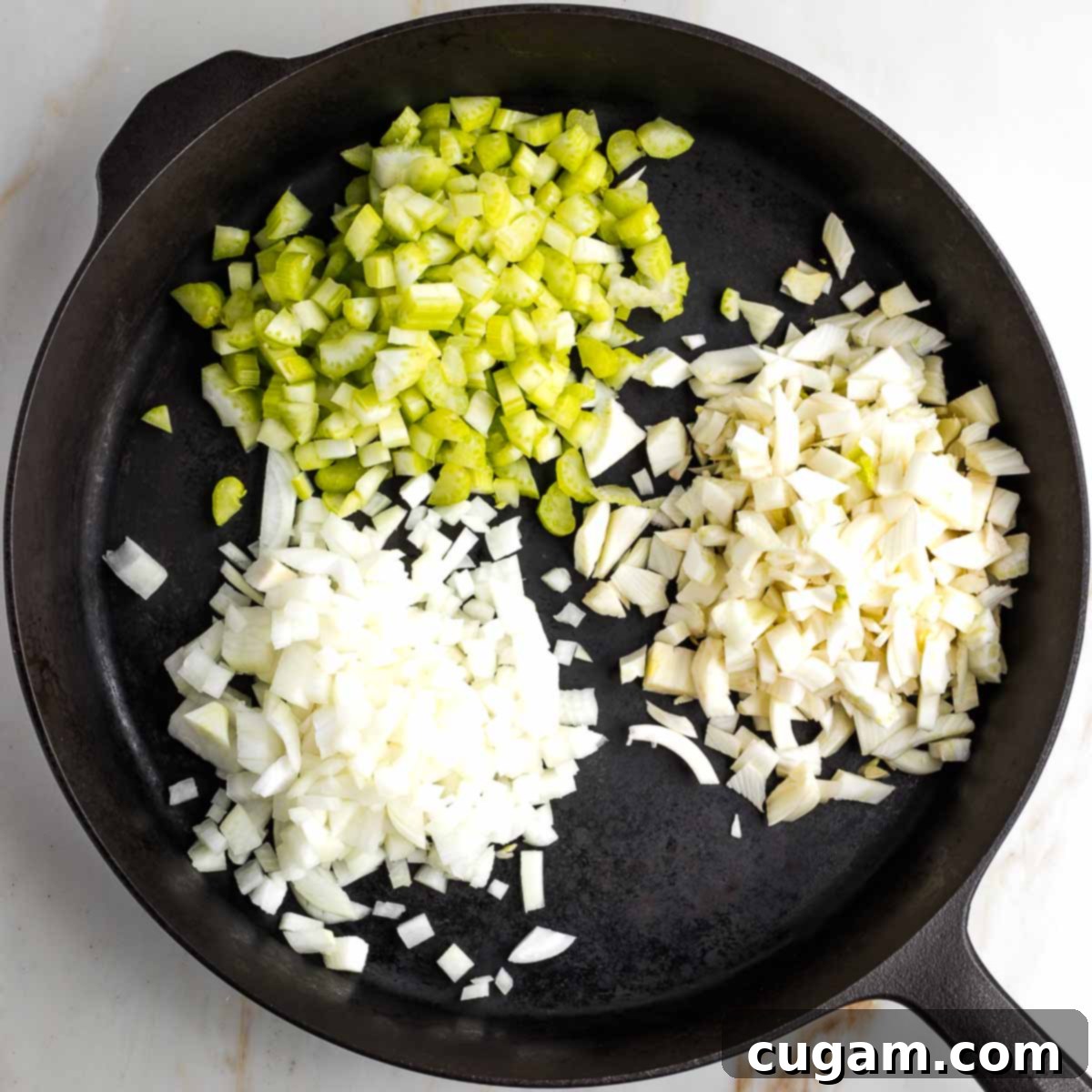
Heat a large skillet (a cast iron skillet works wonderfully for even heat distribution) over medium heat. Add a tablespoon of olive oil or a splash of vegetable broth to sauté your chopped onion, celery, and fennel. Cook for about 5 minutes, stirring occasionally.
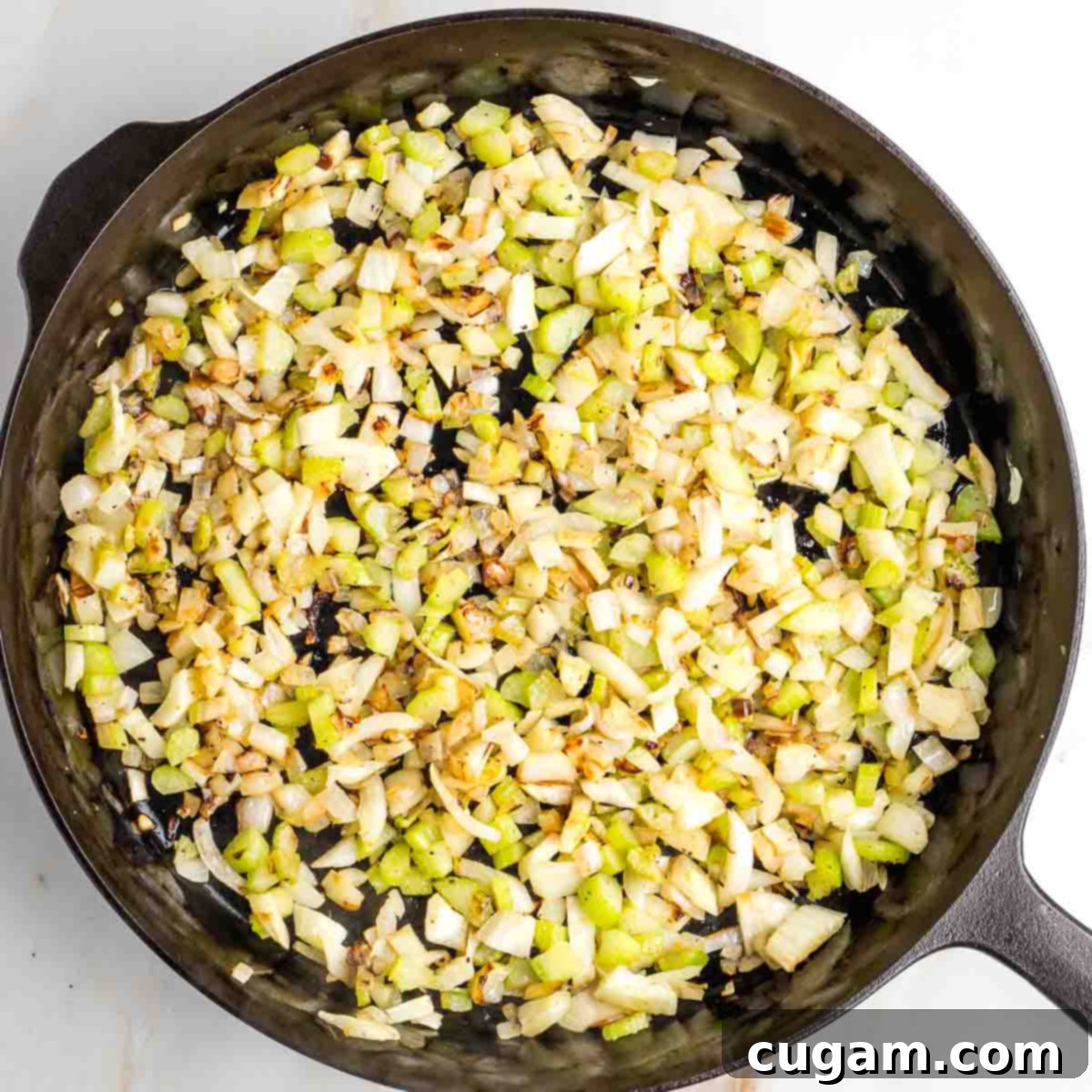
Sprinkle the vegetables with salt and black pepper as they cook. Continue to sauté them until they begin to soften and turn a lovely golden brown. This caramelization is crucial for developing deep, savory flavors in your stuffing.
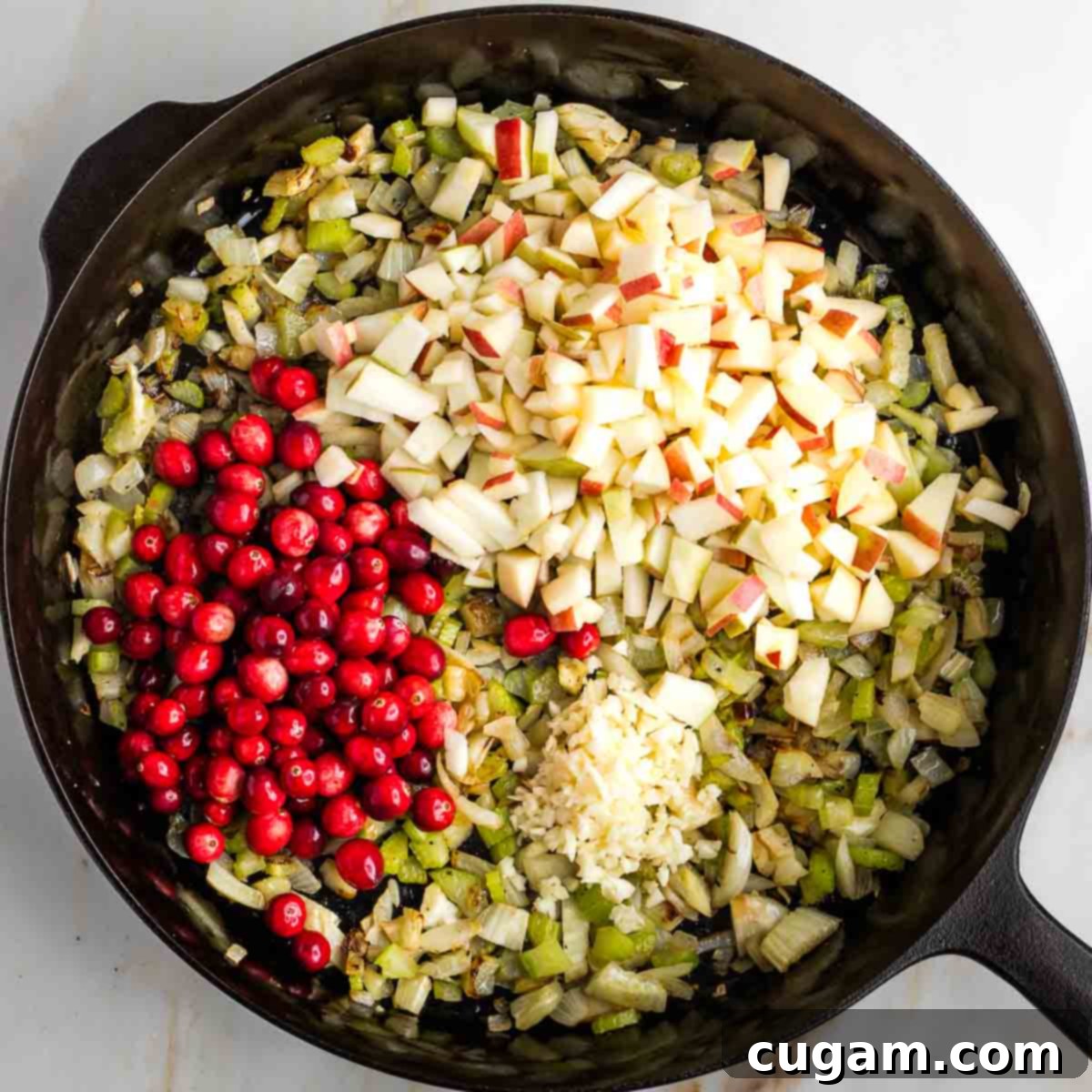
Add the fresh cranberries, diced apples, and minced garlic to the skillet. Pour in ¼ cup of liquid—either vegetable broth, water, white wine, or a combination—to prevent the pan from becoming dry and to help the fruit cook down beautifully.
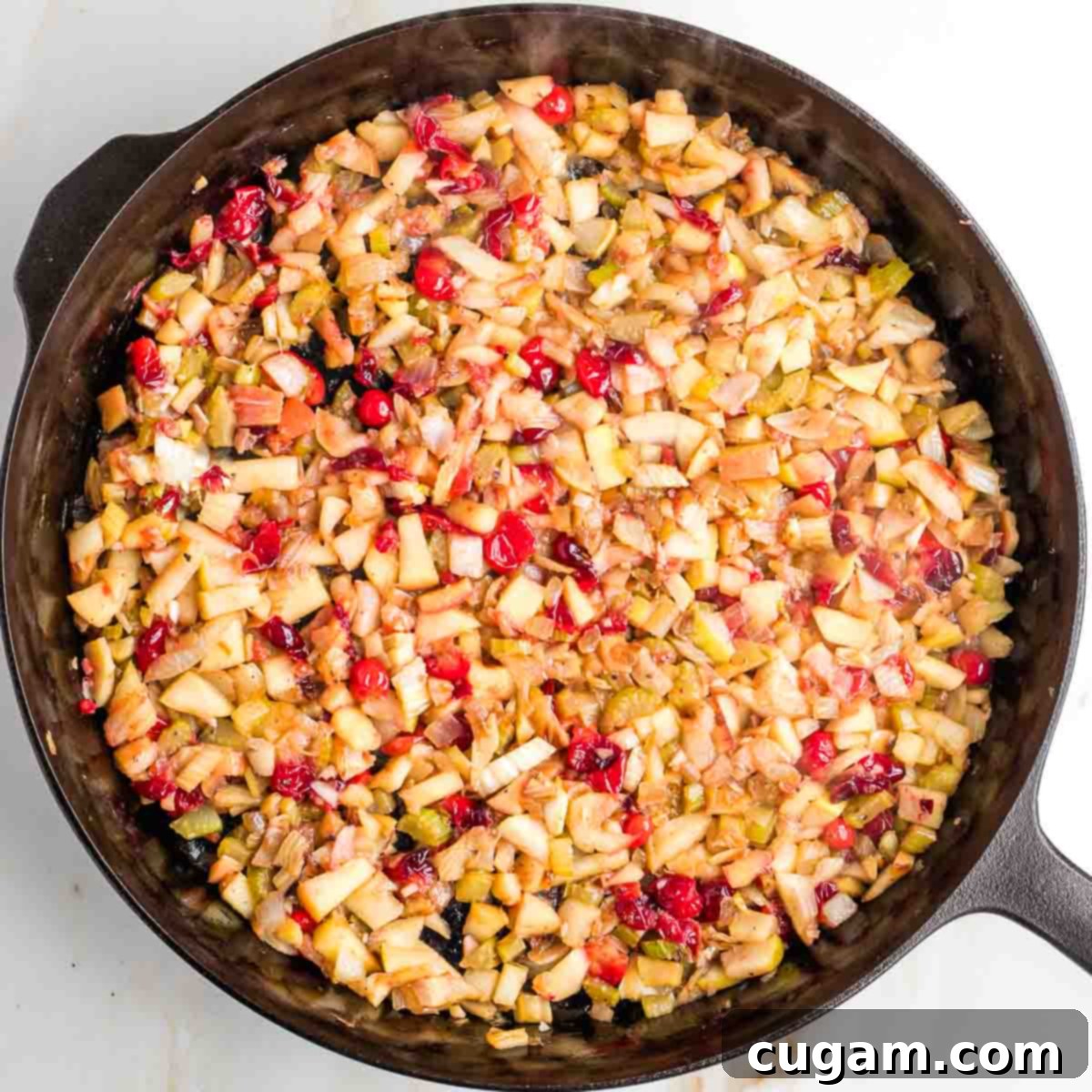
Continue cooking for about 5-8 minutes, stirring occasionally, until the cranberries soften and begin to pop. Use the back of your spoon or spatula to gently mash any cranberries that haven’t burst, releasing their tart juices into the stuffing mixture.
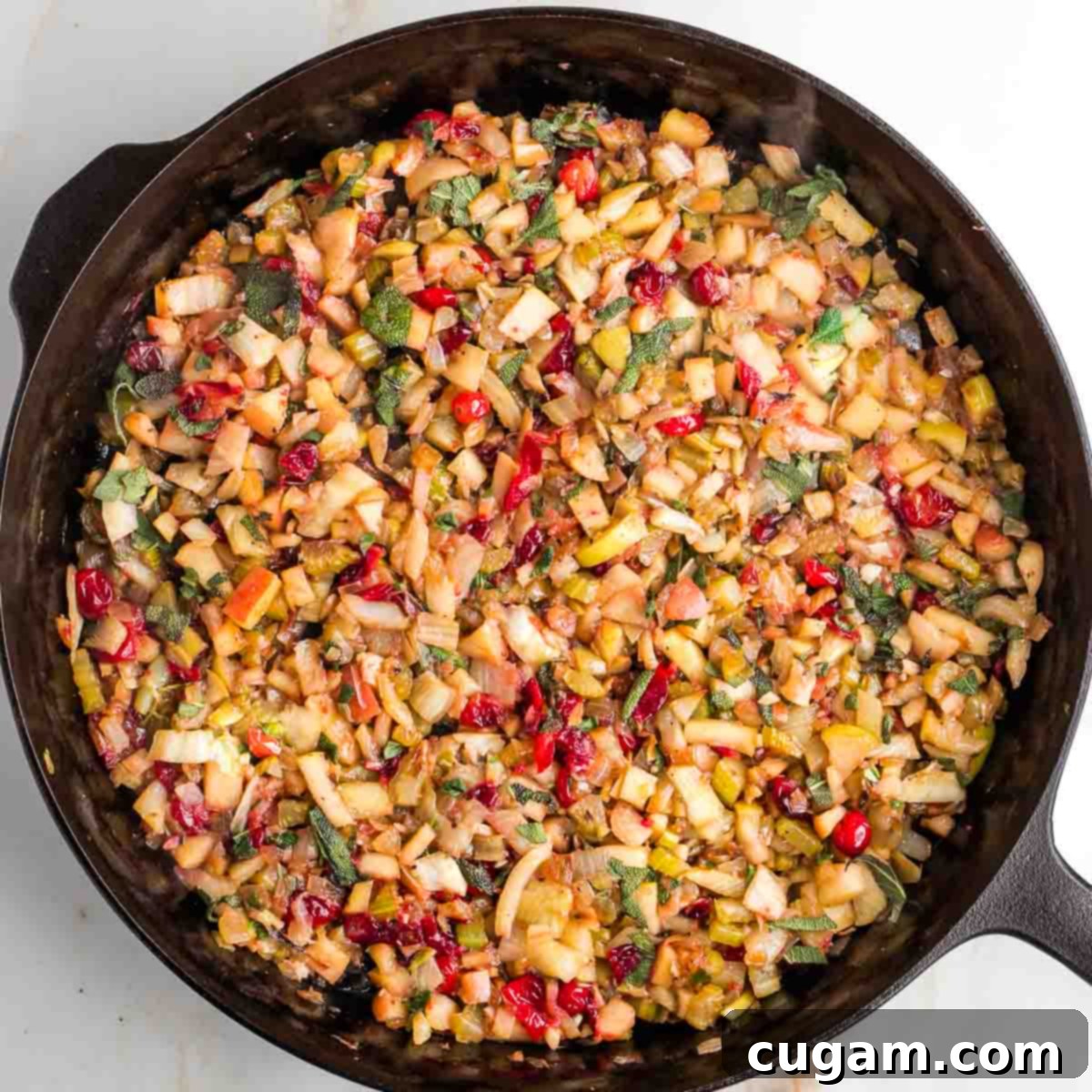
Once the cranberries have softened, turn off the heat. Stir in the freshly chopped sage. Its aromatic essence will perfume the entire stuffing.
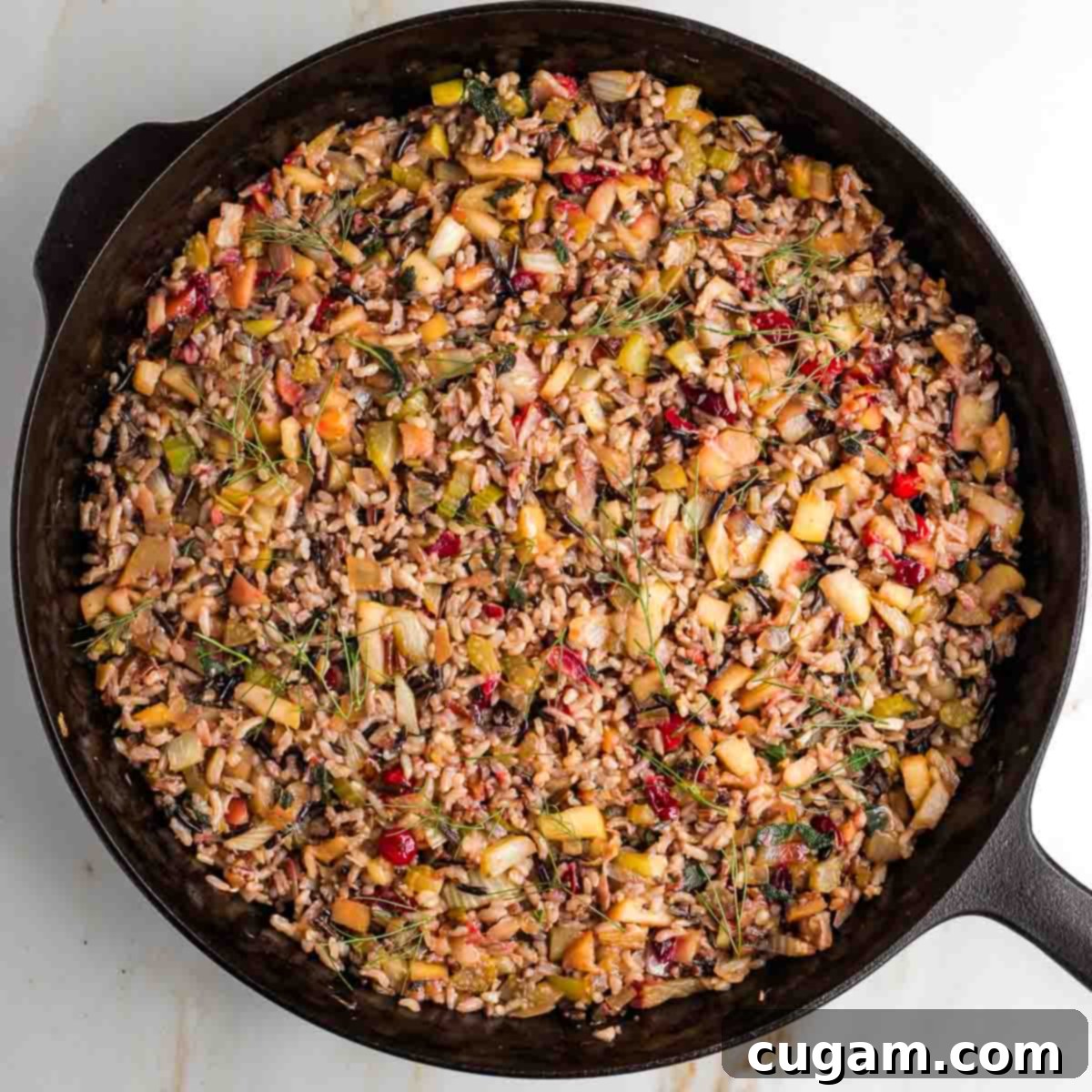
Fluff the cooked wild rice with a fork and then add it to the skillet with the veggie mixture. Mix everything until well incorporated, ensuring every grain of rice is coated with the flavorful sauce. At this stage, the stuffing can be stored in an airtight container in the refrigerator for up to 5 days, making it excellent for meal prepping.
Step 5: Stuff and Serve
The final, satisfying step!
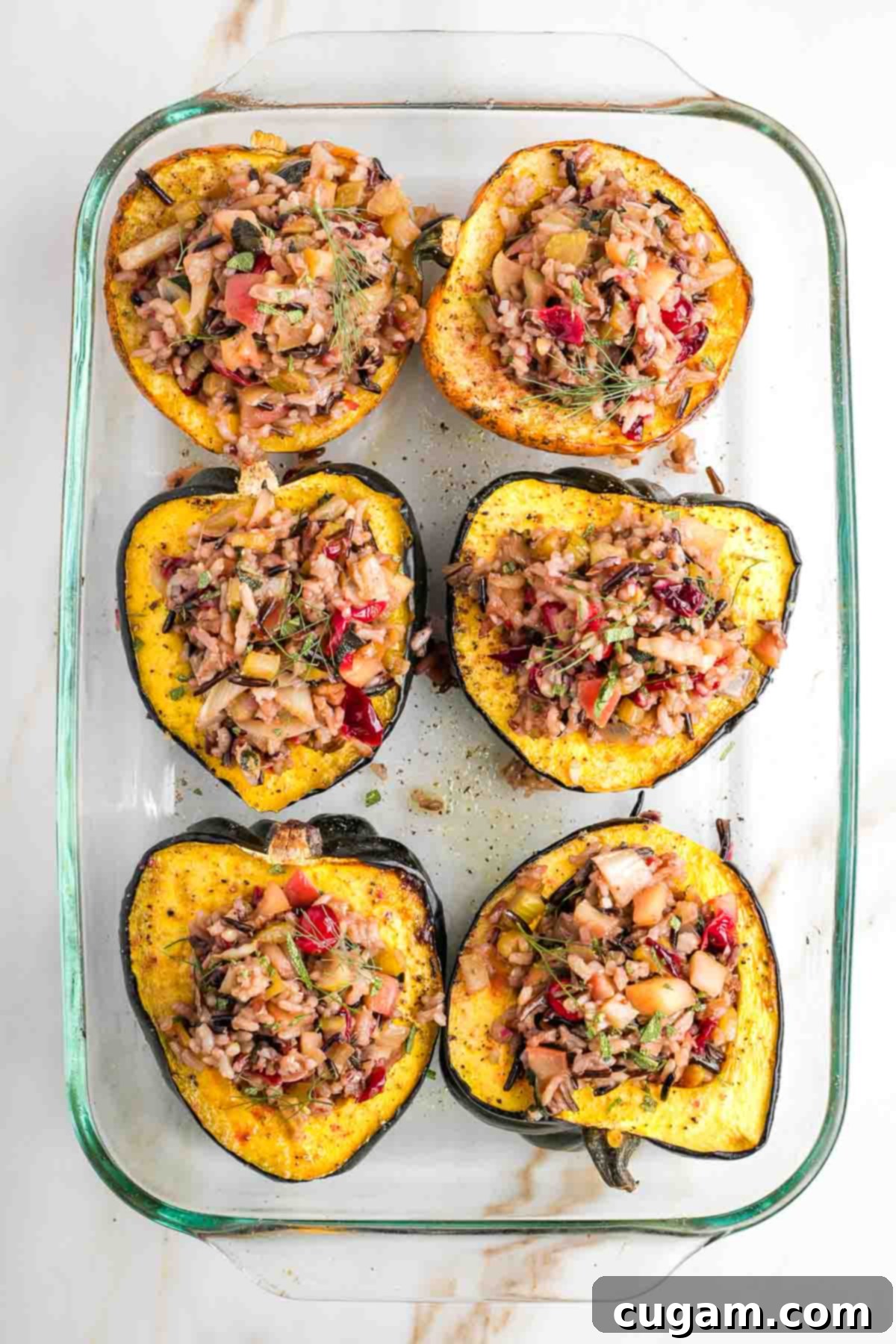
Generously scoop the flavorful wild rice mixture into each cooked acorn squash half. You can serve them immediately, or if you prefer a slightly crispier topping, place the stuffed squash back into the oven at 425 degrees F (220°C) for about 15 minutes. This quick bake will warm the stuffing through and add a delightful texture. If preparing ahead, tightly cover the stuffed squash with aluminum foil and refrigerate until ready to heat and serve.
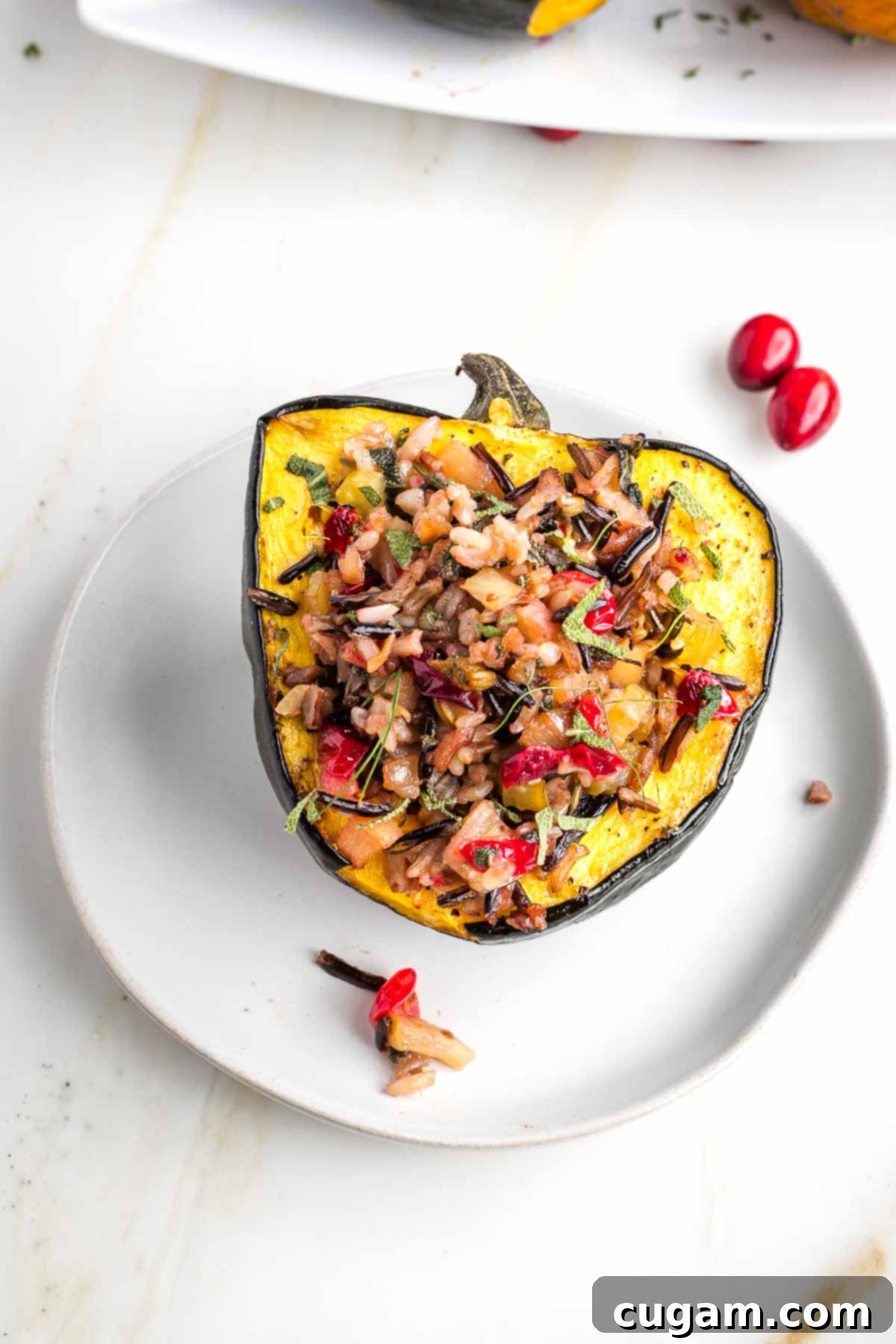
Serving, Storage, and Reheating Tips
Maximize the enjoyment of your vegan stuffed acorn squash with these helpful guidelines:
- Serving: This versatile dish is wonderful served warm or even at room temperature. It makes a complete and satisfying main course on its own, offering a perfect blend of vegetables, grains, and healthy fats. Alternatively, it can be an absolutely stunning and flavorful side dish, adding a festive touch to any holiday table, especially during Thanksgiving or Christmas.
- Storage: The wild rice stuffing can be prepared up to 5 days in advance and stored separately in an airtight container in the refrigerator. Once the squash is stuffed, it can also be stored in the refrigerator, covered tightly, for up to 5 days. For the best texture, I do not recommend freezing the cooked squash, as its texture can become watery upon thawing.
- Reheating: To reheat stuffed squash, preheat your oven to 425 degrees F (220°C). Place the stuffed squash in a baking dish, cover loosely with foil (to prevent drying), and bake for approximately 20 minutes, or until thoroughly heated through and the stuffing is warmed to your liking.
Debra’s Pro Tips for Extra Flair
Elevate your stuffed acorn squash with these expert tips:
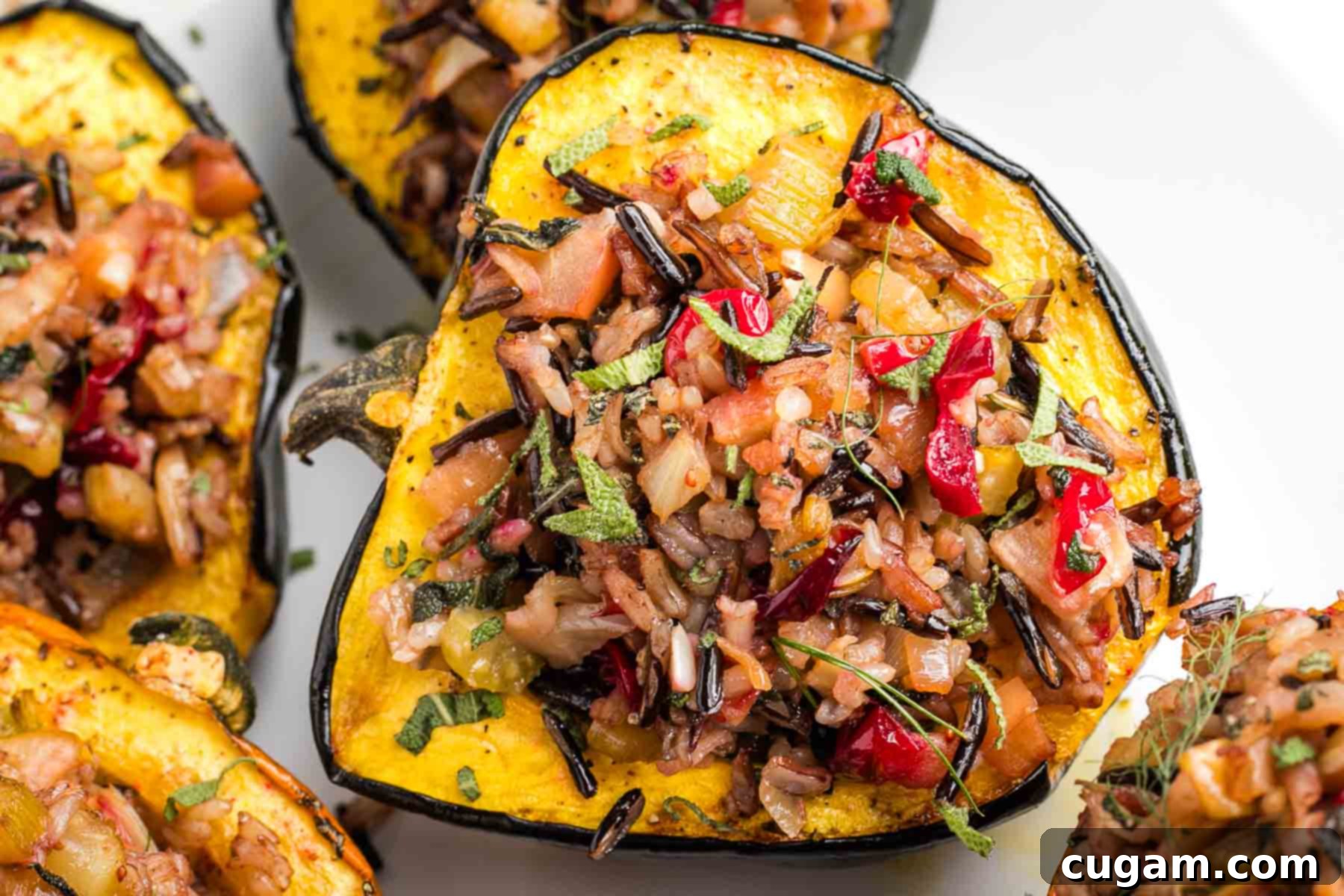
- Roast the Seeds: Don’t discard those acorn squash seeds! Just like pumpkin seeds, they can be cleaned, tossed with a little olive oil and salt, and roasted until crispy. Stir them into the finished stuffing for an extra layer of crunch and a nutty flavor that beautifully complements the dish.
- Adjust Sweetness to Taste: The fresh cranberries will naturally lend a delightful tartness. If you prefer a slightly less tangy profile, consider mixing a tablespoon or two of maple syrup or a dash of brown sugar into the finished stuffing. Taste and adjust until it’s perfect for your palate.
- Stuffing as a Side: This wild rice stuffing is so flavorful, it easily stands alone as a delicious side dish. Prepare a larger batch and serve it in a big bowl alongside other holiday favorites or as a simple accompaniment to any meal.
- Garnish for Presentation: For an elegant touch, garnish the finished stuffed squash with fresh sage leaves or the delicate fronds from the fennel bulb. This adds a pop of color and freshness.
More Irresistible Vegan Thanksgiving Recipes to Try
Looking for more plant-based inspiration for your holiday table? Explore these equally delicious vegan recipes:
- Easy Vegan Gravy Recipe
- Gluten-free Cornbread Stuffing
- Easy Recipe for Green Beans with Almonds
- Butternut and Beetroot Salad
Did you know commenting and rating recipes is one of the best ways to support your favorite food bloggers? If you made this recipe, please consider leaving a five-star rating below and a comment sharing your experience. Also, we’d love to see your creations! Please share your photos on Instagram by tagging me @dkhealthcoach and using the hashtag #debraklein. Your support means the world!
📖 Recipe: Vegan Stuffed Acorn Squash
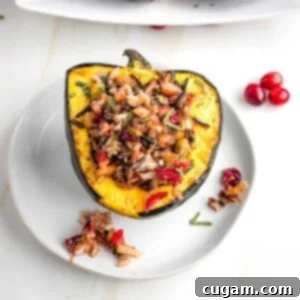
Vegan Stuffed Acorn Squash
Author: Debra Klein
You’re going to love this Acorn Squash with Wild Rice Stuffing. It’s the BEST vegan stuffed acorn squash recipe and it’s so easy to make. Roasted acorn squash halves are filled with a delicious veggie and wild rice blend that’s infused with fresh herbs for an incredibly tasty side dish or vegan main meal.
5 from 29 votes
Rate this Recipe
Pin Recipe
Prep Time: 10 mins
Cook Time: 45 mins
Total Time: 55 mins
Course: Main Course, Side Dish
Cuisine: American
Servings: 6
Calories: 278 kcal
Ingredients
Squash
- 3 small acorn squash, halved
- 1 tablespoon extra virgin olive oil
- ¼ teaspoon sea salt
- ¼ teaspoon ground black pepper
Wild Rice Stuffing
- 1 cup dry wild rice
- 2 ½ cups vegetable broth, divided
- 1 large yellow onion, diced
- 2 stalks celery, diced
- 1 bulb fennel, diced
- ½ teaspoon sea salt
- ½ teaspoon ground black pepper
- 2 large apples, diced
- 1 cup fresh cranberries
- 4 cloves garlic, minced
- 2 tablespoons chopped fresh sage (sub with 2 teaspoons dried sage)
Instructions
- Preheat oven to 400°F (200°C). Use a 9×13 inch casserole dish, or line a baking tray with unbleached parchment paper.
- Roast the Squash: Wash the outside of the squash before beginning. Cut a small sliver off the bottom of each squash, just enough so it sits flat on a cutting board. Halve the squash through the stem and scoop out and discard the seeds and strings. Place in the prepared pan and drizzle with olive oil, then sprinkle with salt and pepper. Bake for 40-45 minutes, until fork tender.
- Cook the Rice: Rinse the wild rice well in a fine mesh sieve until the water runs clear. In a small saucepan, bring 2 cups of vegetable broth to a boil. Stir in the rinsed rice, reduce to medium-low heat, and simmer covered for 25 minutes. Turn off heat and leave covered for 10 more minutes to finish steaming.
- Prep the Veggies: Dice the onion, celery, fennel, and apples. Mince the garlic cloves. Rinse the cranberries and pick through, discarding any stems or damaged berries. Stack the sage leaves and roughly chop.
- Make the Stuffing: While the rice and squash are cooking, prepare the rest of the filling. Use veggie broth or olive oil to sauté onion, celery, and fennel in a heavy skillet over medium heat for 5 minutes. Stir in the cranberries, diced apples, and minced garlic along with ¼ cup of the broth. Cook for another 5-8 minutes, stirring occasionally, as the cranberries begin to pop. Use the back of your spoon or spatula to mash a few of the cranberries. Turn off the heat and mix in the chopped sage. Fluff the cooked rice with a fork and then stir it into the veggie mixture until well combined.
- Squash is finished when fork tender. Fill the cooked squash halves with generous scoops of the stuffing. Sprinkle with additional fresh sage or use the fronds from the fennel to garnish. If you’d like to crisp up the rice stuffing, put the stuffed squash back into the oven at 425°F (220°C) for 15 minutes.
- Meal Prep: You can prepare the wild rice up to 3 days in advance. The stuffing filling can also be made up to 3 days ahead. Stuff the squash and refrigerate in a baking dish covered with foil until ready to use. Reheat in a 375°F (190°C) oven for 20 minutes, or until heated through.
Notes
For no oil acorn squash: To roast without oil, simply sprinkle squash halves with salt and pepper and turn them cut side down to roast in the oven. This helps them retain moisture and prevents drying out. Continue as directed above.
If squash halves don’t sit flat in the baking dish, carefully cut a super thin sliver off the ridgy bottom. This will create a flat surface and ensure they sit stably without wobbling during roasting.
Nutrition
The nutrition calculations were done using online tools. To obtain the most accurate representation of the nutritional information in any given recipe, you should calculate the nutritional information with the actual ingredients you used. You are ultimately responsible for ensuring that any nutritional information is accurate, complete and useful.
- Calories: 278 kcal
- Carbohydrates: 58g
- Protein: 7g
- Fat: 4g
- Saturated Fat: 1g
- Polyunsaturated Fat: 1g
- Monounsaturated Fat: 2g
- Sodium: 331mg
- Potassium: 1163mg
- Fiber: 9g
- Sugar: 11g
- Vitamin A: 960IU
- Vitamin C: 35mg
- Calcium: 121mg
- Iron: 3mg
Did you make this recipe?
Please leave a review below, then snap a picture and tag me @dkhealthcoach or use hashtag #dkhealtcoach on Instagram so I can see it!!
